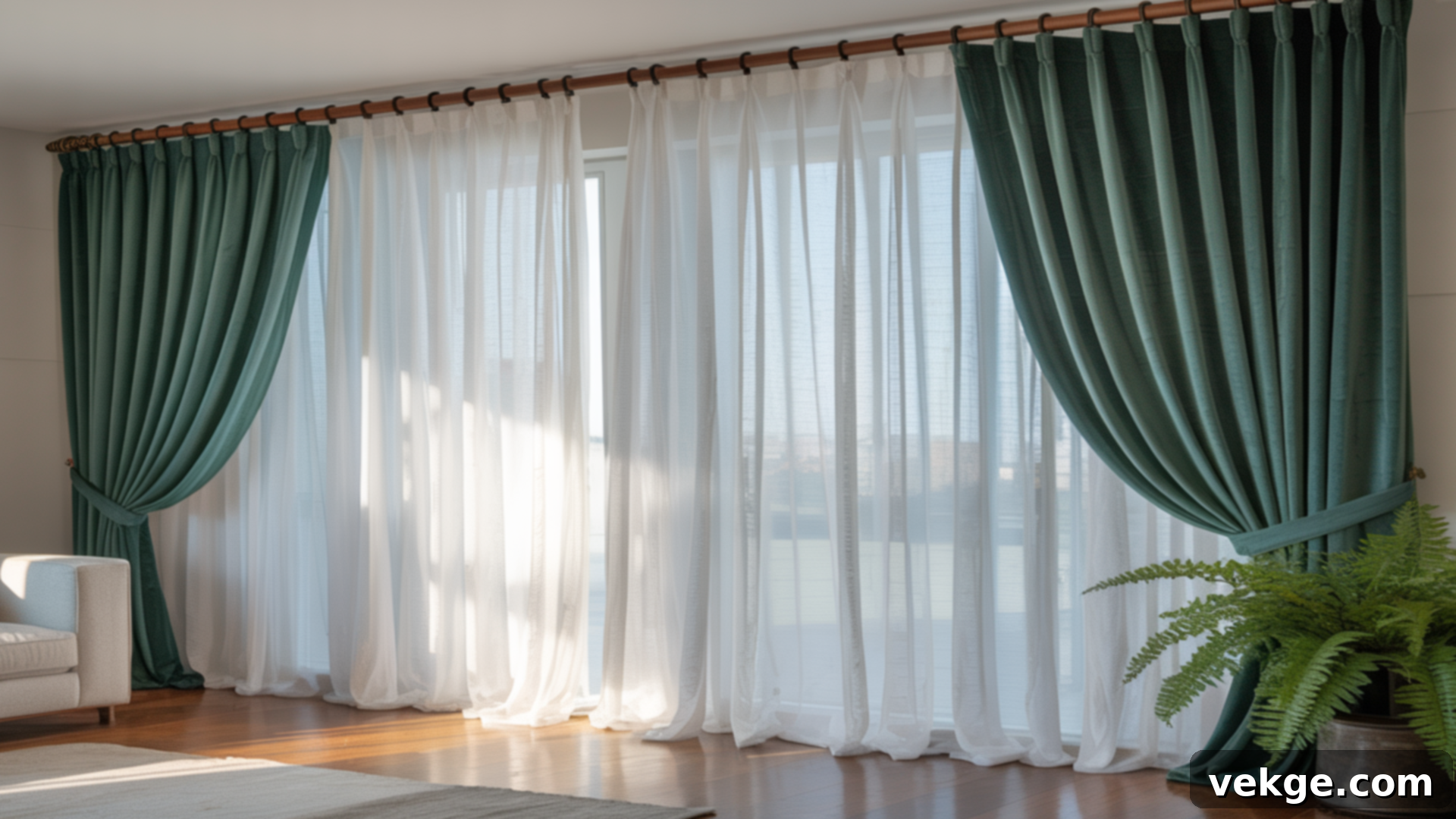Elevate Your Home: The Ultimate Guide to Layering Curtains for Enhanced Style, Privacy, and Light Control
Are you looking to refresh your windows with a touch of elegance while simultaneously boosting privacy and gaining precise light control? Layering curtains is a remarkably simple yet profoundly effective way to achieve all these goals. This comprehensive guide will walk you through the art of combining sheer and blackout curtains to create a window treatment that is both stunning and highly functional.
Discover how to select the perfect fabrics, install curtain rods with ease, and utilize tiebacks and holdbacks to complete a polished, sophisticated look. By the end of this guide, you’ll possess all the essential tips and tricks needed to design window treatments that perfectly complement your home’s aesthetic and meet your practical needs. Ready to transform your living spaces with the beauty and versatility of layered curtains? Let’s begin your journey to beautifully dressed windows!
Unlock the Benefits of Layering Curtains for Your Home
Layering curtains offers much more than just a pretty facade; it brings a multitude of practical advantages that significantly enhance the comfort and functionality of your living environment. Here’s why this design choice is a smart investment for any home:
- Improved Insulation and Energy Efficiency: Adding multiple layers of fabric to your windows creates an insulating barrier. This extra warmth in winter helps to reduce heat loss, preventing drafts and keeping your room cozier. In the summer, these layers work to block out excessive heat, keeping your indoor spaces cooler. The result? A more stable indoor temperature, less reliance on heating and air conditioning, and noticeable savings on your energy bills year-round.
- Enhanced Privacy at Any Time: The beauty of layered curtains lies in their dual-purpose privacy. Sheer curtains provide a delicate veil during the day, allowing natural light to filter through while maintaining a sense of privacy from outside views. When night falls, or when absolute seclusion is desired, heavier drapes or blackout curtains can be drawn to offer complete and impenetrable privacy, giving you peace of mind in your personal space.
- Better, More Flexible Light Control: Layering gives you unparalleled control over the amount of natural light entering your room. Sheer curtains gently diffuse sunlight, reducing glare and creating a soft, inviting ambiance without completely blocking your view. When you need to darken a room for sleeping, watching movies, or simply to create a more intimate atmosphere, the heavier outer layer can be closed to block out light completely, offering truly customizable brightness for any occasion.
- Exceptional Visual Interest and Style: Beyond their functional benefits, layered curtains are a powerful design tool. They add significant depth, texture, and dimension to your windows, transforming them into a sophisticated focal point in any room. By mixing different fabrics—such as delicate sheers with rich velvet drapes—and experimenting with complementary or contrasting colours, you can create a unique, luxurious look that enhances your room’s overall design scheme and reflects your personal style.
Common Types of Curtains Used in Layering Designs
To successfully layer curtains, understanding the distinct characteristics of each type is crucial. Choosing the right combination ensures both optimal style and function. Here are the most common options you’ll encounter:
- Sheer Curtains: These are typically made from lightweight, translucent fabrics like voile, lace, or thin linen blends. Sheer curtains are designed to be light and airy, allowing natural light to generously flood your room while still offering a basic level of privacy during daylight hours. They are almost always used as the inner layer in a layered setup, providing a soft, ethereal backdrop and filtering harsh sunlight into a gentler glow without obstructing your view of the outside world.
- Blackout Curtains: Crafted from thick, densely woven fabrics, often with a special lining (like foam-backed or thermal fabric), blackout curtains are specifically engineered to block out nearly all incoming light. They are incredibly effective at creating complete darkness, making them indispensable for bedrooms, nurseries, home theatres, or any space where maximum light control is essential. Beyond light blocking, their substantial weight also contributes to sound dampening and insulation, enhancing comfort and quiet.
- Drapes (or Decorative Curtains): This broad category encompasses a wide variety of curtain styles, fabrics, and weights. Drapes are similar to blackout curtains in their ability to offer privacy and block light (especially when lined), but their primary role in layering is often aesthetic. They are typically used as the outer layer, adding significant elegance, texture, colour, and insulation to your window treatment. Fabrics can range from luxurious velvet and silk to practical cotton and linen, offering endless possibilities for complementing your home’s decor and adding a touch of sophisticated flair.
By thoughtfully combining these curtain types, you can create a dynamic, multi-faceted layered window treatment that perfectly balances your needs for light, privacy, and style.
How to Layer Curtains: A Comprehensive Step-by-Step Guide
Achieving a perfectly layered curtain look might seem daunting, but with this detailed, step-by-step guide, you’ll master the art of creating a stylish, functional, and truly transformative window treatment for any room in your home.
1. Choosing the Right Curtains: Fabrics, Colors, and Measurements
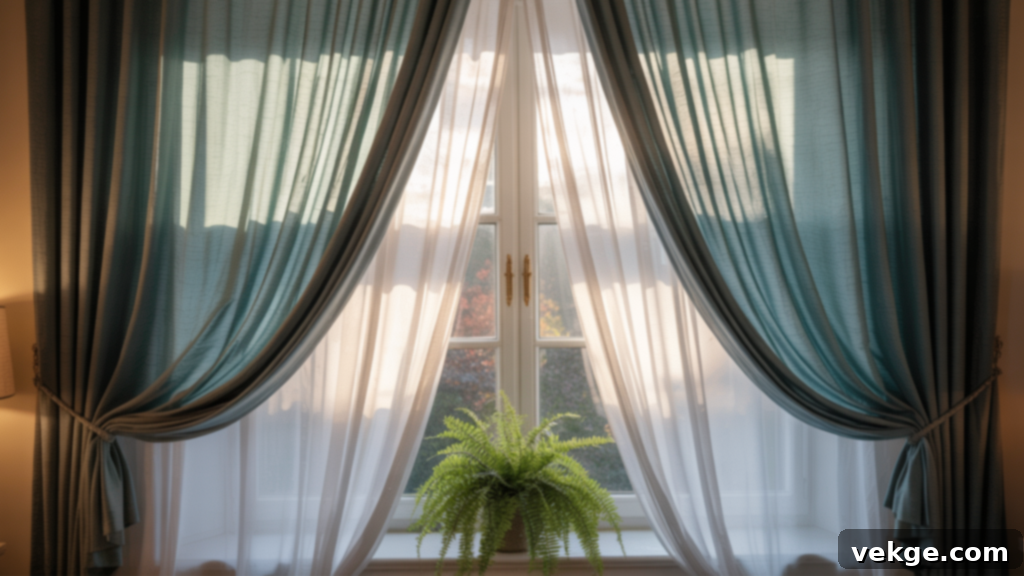
The foundation of a successful layered look begins with selecting the right curtains. This involves careful consideration of fabric, color, and precise measurements.
- Sheer Curtains: These are your inner layer. Opt for light and airy fabrics like voile, chiffon, or a delicate linen blend. They should allow natural light to filter through while maintaining a daytime sense of privacy. Choose a color that either closely matches your wall color for a subtle look or a complementary shade that softly introduces another hue into your scheme.
- Heavier Curtains (Drapes or Blackout): These form your outer, functional layer. Select heavier fabrics such as velvet, linen, cotton, or thermal-backed materials for enhanced light control, privacy, and insulation. Consider how the fabric’s texture will interact with your sheer layer; for example, a soft sheer paired with a rich velvet drape creates a striking contrast.
- Colour and Pattern Coordination: Decide if you want your layered curtains to blend seamlessly or create a bold statement. You can choose sheers and drapes in different shades of the same color for a cohesive, monochromatic look, or opt for contrasting colors to add drama and visual interest. If one layer has a pattern, keep the other solid to avoid overwhelming the space.
- Measuring for Perfection: Accurate measurements are paramount.
- Width: For a luxurious, full look, your curtains should be 1.5 to 3 times the width of your window frame (or rod length). This ensures ample fabric for pleats and gathering when closed.
- Length: Determine your desired curtain length. Common choices include:
- Just brushing the floor: A classic, tailored look, usually 0.5 to 1 inch above the floor.
- Breaking the floor: Where the curtain lightly pools on the floor (an extra 1-3 inches).
- Puddling: A more dramatic, opulent look where fabric pools significantly (an extra 6+ inches).
- Sill length: Less common for layered looks, but suitable for windows above radiators or furniture, usually just touching or slightly above the windowsill.
2. Selecting the Right Curtain Rods: Support and Style
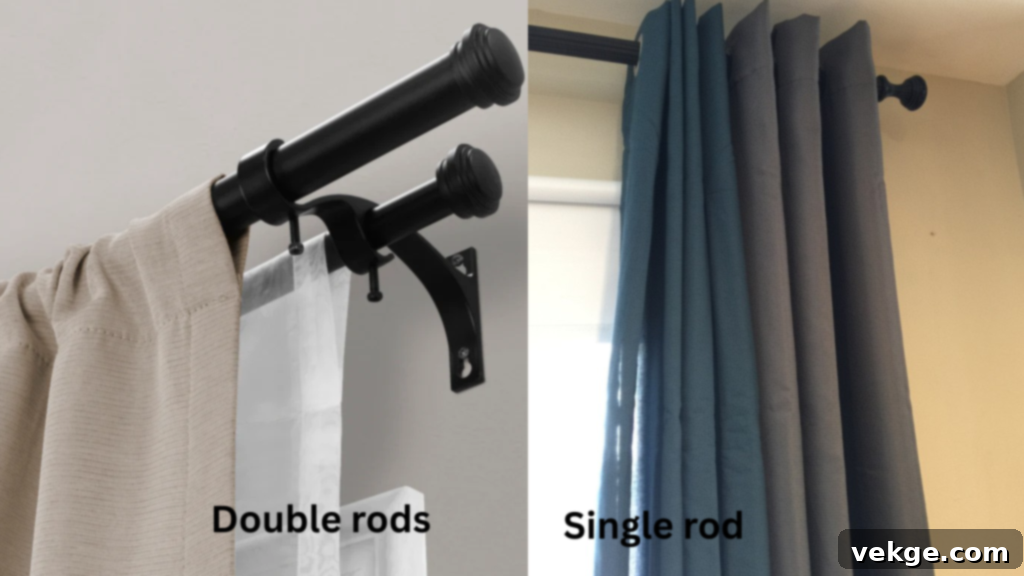
The choice of curtain rods is critical for both the functionality and aesthetics of your layered window treatment.
- Double Rod Systems: For the most flexible and elegant layered look, double curtain rods are highly recommended. These systems feature two parallel rods, allowing you to hang sheer curtains on the inner rod (closer to the window) and heavier drapes on the outer rod. This setup provides maximum flexibility for adjusting light and privacy independently. They come in various styles, from simple decorative rods to traverse rods (which allow curtains to be pulled smoothly with a cord).
- Single Rods with Creative Solutions: While double rods are ideal, it is possible to layer with a single rod if space or budget is a concern. This requires more careful arrangement, often using clip rings or a combination of hanging methods. For instance, you could use clip rings for the drapes and a rod pocket for the sheers on the same rod, ensuring the sheers are behind the drapes. However, this offers less independent control.
- Material and Sturdiness: Always choose sturdy rods capable of supporting the combined weight of both curtain layers. Metal rods (iron, brass, chrome) are excellent for heavier drapes, while decorative wooden rods also provide robust support and a classic look. Ensure the brackets provided are strong and appropriate for the rod’s length and expected load. Don’t forget finials – the decorative ends of the rods – which contribute significantly to the overall aesthetic.
- Rod Length: The rod should extend at least 6-12 inches beyond the window frame on each side. This allows the curtains to be drawn completely off the window, maximizing natural light when desired, and creates the illusion of a wider window.
3. Installation Tips for a Professional Finish
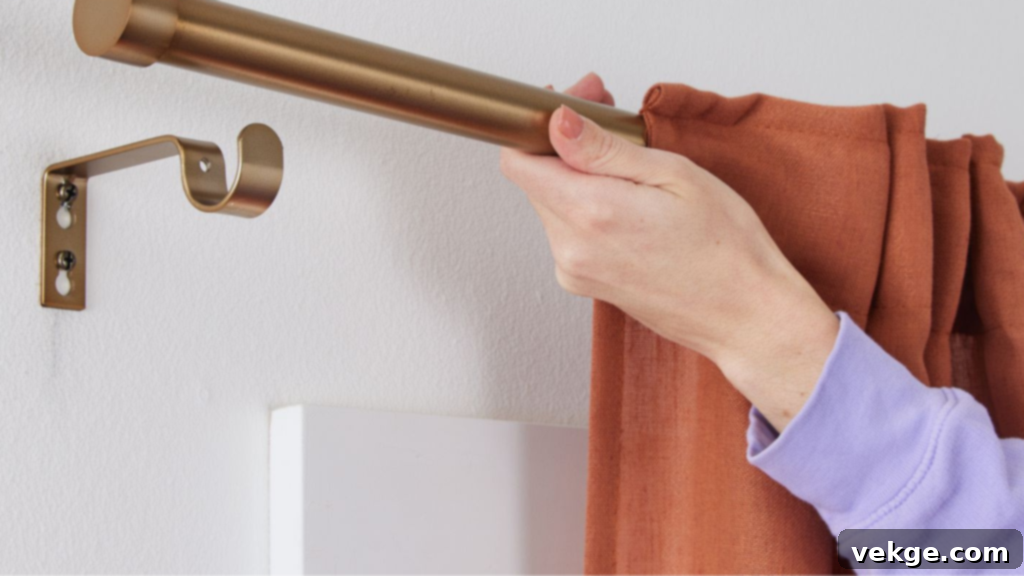
Proper installation is key to achieving that polished, high-end look. Follow these tips to ensure your layered curtains are hung perfectly:
- “Hang High and Wide”: This is a golden rule in curtain installation. Mount your curtain rods approximately 4-6 inches above the window frame for a standard ceiling height, or even closer to the ceiling for a more dramatic, taller window illusion. Extending the rods 6-12 inches beyond the window frame on each side makes the window appear wider and allows the curtains to be fully pulled back, exposing the entire window.
- Secure Mounting: Always ensure your rods are securely mounted. Use a stud finder to locate wall studs for the strongest support. If mounting into drywall or hollow walls, use appropriate wall anchors (toggle bolts or self-drilling anchors are often best for curtains) and screws to prevent sagging or pulling away from the wall, especially with heavier drapes. Use a level to ensure the rods are perfectly straight.
- Bracket Placement: For rods longer than 60 inches or carrying heavy curtains, use a center support bracket to prevent bowing. Distribute brackets evenly for maximum stability.
- Order of Hanging: If using a double rod system, always place the lighter sheer curtains on the inner rod (closest to the window) and the heavier drapes or blackout curtains on the outer rod. This maintains the aesthetic of the sheer layer being visible and easily accessible.
4. Hanging the Curtains: Creating a Balanced and Tidy Appearance
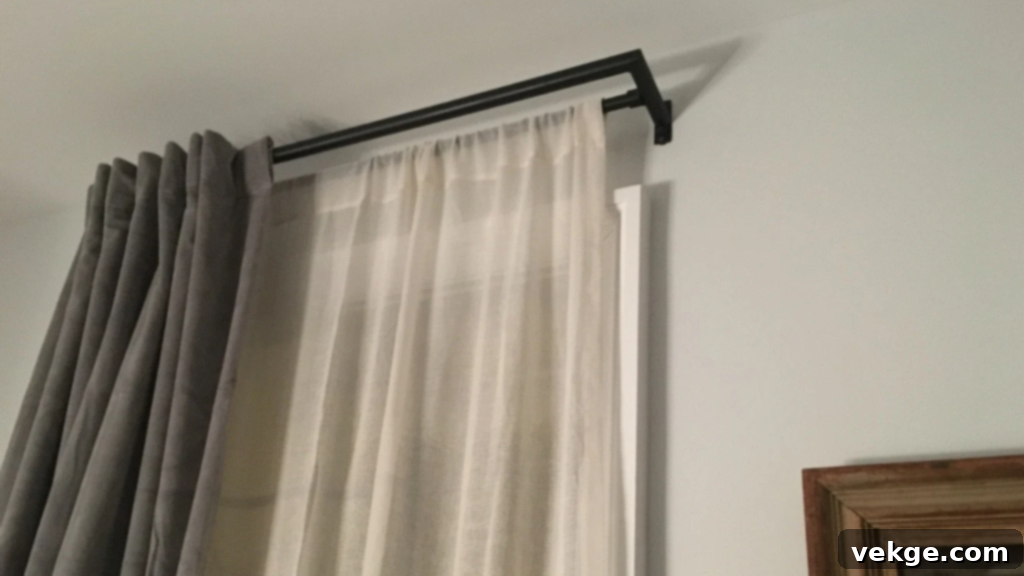
Once your rods are securely installed, it’s time to hang your beautiful curtains. This step focuses on presentation and ensuring everything looks just right.
- Layering Order: Reiterate the rule: sheer curtains on the inner rod, heavier drapes on the outer rod. This order is essential for both functionality and visual appeal.
- Even Distribution: Gently spread each curtain panel across its respective rod. Ensure that pleats, folds, or grommets are evenly spaced. This creates a neat, balanced look whether the curtains are open or closed. If using clip rings, space them equidistant for a consistent drape.
- Hanging Styles: Consider the header style of your curtains.
- Grommets: Naturally create soft, even folds.
- Rod Pockets: Offer a more gathered, traditional look.
- Back Tabs: Provide a clean, tailored pleat without visible hardware.
- Pinch Pleats: Give a formal, structured appearance, often hung with hooks on rings.
Adjusting the fabric to create crisp, defined pleats or soft, flowing gathers will elevate the overall design.
- Steaming and Ironing: Before hanging, consider steaming or ironing your curtains to remove any creases or wrinkles from packaging. This simple step can make a significant difference in how professional and luxurious your window treatment appears.
By diligently following these steps, you will successfully achieve a functional and stylish layered curtain setup that not only enhances the look and feel of your room but also provides practical benefits for years to come.
Extra Touches for a Polished Layered Look
Once your layered curtains are hung, a few final details can elevate the entire ensemble, making it feel truly custom and complete.
Tiebacks and Holdbacks: Function Meets Fashion
Tiebacks and holdbacks are both practical and beautiful additions to your layered curtains, serving to hold them open while adding a decorative flourish.
- Tiebacks: These are typically soft fabric bands, cords, or decorative ropes that wrap around the gathered curtain panels, pulling them back from the window. They allow more light into the room during the day and keep your curtains neatly out of the way, preventing them from bunching up or obstructing the view. Tiebacks come in countless styles, from simple fabric straps matching your drapes to elaborate rope tassels with decorative elements.
- Holdbacks: Mounted directly onto the wall on either side of the window, holdbacks are rigid, decorative pieces (often made of metal, wood, or crystal) designed to catch and hold the curtain panels when they are pulled open. They offer a more formal and structured appearance than tiebacks.
- Styling Choices: Consider the overall aesthetic of your room and curtains when choosing tiebacks or holdbacks.
- For a casual, rustic, or bohemian feel, opt for natural rope tiebacks or simple fabric bands.
- For a more modern, glamorous, or traditional look, metal and crystal holdbacks or ornate tassel tiebacks can add significant sophistication.
- Fabric tiebacks that match or complement your heavier drapes provide a soft, cohesive touch.
These small details not only serve a crucial functional purpose but also significantly enhance the overall aesthetic, giving your windows a polished and elegant appearance.
Adjusting for Optimal Light and Privacy Throughout the Day
One of the most compelling advantages of layered curtains is their incredible versatility in managing light and privacy. You gain complete control over your environment, allowing you to adapt to various needs and moods throughout the day:
- Daytime Ambiance: In the morning or during the day, you can pull back your heavier outer drapes using your tiebacks or holdbacks. This allows your sheer curtains to take center stage, filtering natural light into the room. The sheers will diffuse harsh sunlight, reduce glare, and create a soft, inviting glow while still maintaining a pleasant level of daytime privacy from outside observers.
- Increased Privacy (Daytime): If you need more privacy during the day but still desire some natural light, you can leave the sheers closed across the window. Depending on their opacity, they will provide a greater sense of seclusion than an uncovered window while still preventing the room from feeling completely enclosed.
- Complete Darkness and Privacy (Nighttime): For maximum privacy, especially at night, or when you want to block out light completely (for sleeping, watching movies, or creating a cozy retreat), simply close the heavier drapes over the sheer layer. This combination provides superior light blockage and an impenetrable barrier against outside views.
- Energy Efficiency: By strategically opening and closing your layers, you can also manage thermal comfort. Keep both layers closed on hot, sunny days to block heat, or on cold nights to retain warmth, contributing to better energy efficiency in your home.
This dynamic control allows you to customize the light entering the room and the level of privacy, making your layered curtains a truly responsive and adaptable window solution.
Common Issues and Solutions for Layering Curtains
While layering curtains offers immense benefits, a few common challenges can arise during selection and installation. Being aware of these and knowing the solutions will help you achieve a flawless look.
- Problem: Curtains are too long or too short.
- Solution: Ensure you take precise measurements before purchasing. If curtains are slightly too long, hemming tape or a professional alteration can achieve the perfect “kiss the floor” or “break the floor” look. For curtains that are too short, consider extending the rod height if possible, or embrace a sill-length look for the sheer layer, though this is less common for the outer drapes.
- Problem: Curtains look bulky or uneven when open.
- Solution: This often happens if there isn’t enough wall space beyond the window frame for the curtains to stack neatly. Ensure your curtain rod extends at least 6-12 inches past the window frame on each side. Additionally, regularly adjust your tiebacks or holdbacks and arrange the fabric folds to prevent an untidy appearance. For very wide windows or heavy curtains, consider a third, central bracket for better support and spread.
- Problem: Rods are sagging or pulling away from the wall.
- Solution: This indicates insufficient support. Always use robust hardware, including appropriate wall anchors for drywall (e.g., toggle bolts, self-drilling anchors) or screw directly into wall studs. For longer or heavier curtain sets, always include a center support bracket. Replace flimsy brackets with sturdier alternatives if necessary.
- Problem: Sheer and outer curtains don’t move smoothly.
- Solution: Ensure you are using a double rod system where each layer has its own rod, allowing independent movement. If using a single rod, ensure the hanging method (e.g., rings with clips) is appropriate for smooth gliding. Sometimes, a silicone-based lubricant spray on metal rods can improve movement.
- Problem: Design doesn’t feel cohesive.
- Solution: Re-evaluate your fabric choices and colors. Do they complement each other, or are they clashing? Consider incorporating a third, unifying color in accessories or subtly picking up a pattern from one layer in another element of the room. Sometimes, using sheer curtains in a neutral tone (white, cream, grey) and letting the drapes carry the main color or pattern provides better cohesion.
Conclusion: Transform Your Space with Layered Curtains
Layering curtains is an incredibly versatile and impactful design technique that can profoundly boost your space’s comfort, style, and functionality. As we’ve explored, the strategic combination of light-filtering sheer curtains with robust, privacy-enhancing drapes not only offers unparalleled control over light and privacy but also introduces significant depth, texture, and visual interest to your windows, transforming them into captivating focal points.
From carefully selecting the perfect fabrics and ensuring precise measurements to choosing the right curtain rods, meticulously installing them, and adding the finishing touches with tiebacks or holdbacks, every detail contributes to a more polished, practical, and aesthetically pleasing design. This thoughtful approach ensures your window treatments are not just functional but truly elevate your home’s interior.
Now that you possess a comprehensive understanding of how to master the art of layering curtains, we encourage you to try it in your own home! It’s a design decision that can genuinely transform your living space, making it more inviting, comfortable, and reflective of your personal style. For even more expert décor tips and inspiring ideas, be sure to explore our other blogs for additional insights and creative solutions.
